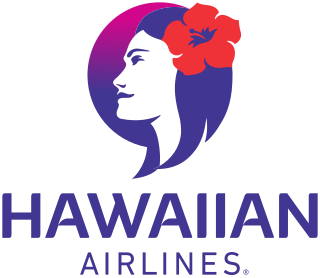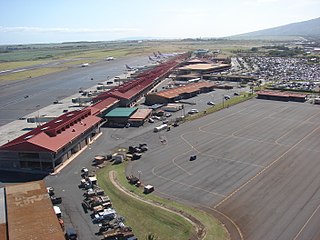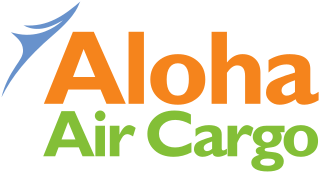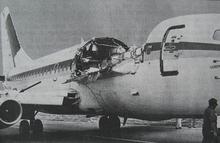
ATA Airlines, Inc. – formerly known as American Trans Air and commonly referred to as ATA – was an American low-cost scheduled service and charter airline based in Indianapolis, Indiana. ATA operated scheduled passenger flights throughout the U.S. mainland and Hawaii, Puerto Rico, and Portugal as well as military and commercial charter flights around the world. In its early days, the airline flew charters on a worldwide basis and had bases in Chicago, Detroit, New York, Indianapolis, Oakland, and Milwaukee. Later, when it entered scheduled service, the airline maintained focus cities at Chicago Midway International Airport, Honolulu International Airport, and Oakland International Airport.

Hawaiian Airlines is a commercial U.S. airline, headquartered at Honolulu, Hawaii. It is the largest operator of commercial flights to and from the island state of Hawaii, and the tenth-largest commercial airline in the United States.

Daniel K. Inouye International Airport, also known as Honolulu International Airport, is the main and largest airport in Hawaii. The airport is named after Honolulu native and Medal of Honor recipient Daniel Inouye, who represented Hawaii in the United States Senate from 1963 until his death in 2012. The airport is in the Honolulu census-designated place 3 miles (5 km) northwest of Honolulu's central business district. The airport covers 4,220 acres, more than 1% of Oahu's land.

Kahului Airport is the main airport of Maui in the State of Hawaii, United States, located east of Kahului. It has offered full airport operations since 1952. Most flights into Kahului Airport originate from Daniel K. Inouye International Airport in Honolulu; the Honolulu–Kahului corridor is one of the heaviest-trafficked air routes in the US, ranking 13th in 2004 with 1,632,000 passengers.

Aloha Airlines Flight 243 was a scheduled Aloha Airlines flight between Hilo and Honolulu in Hawaii. On April 28, 1988, a Boeing 737-297 serving the flight suffered extensive damage after an explosive decompression in flight, caused by part of the fuselage breaking due to poor maintenance and metal fatigue. The plane was able to land safely at Kahului Airport on Maui. The one fatality, flight attendant Clarabelle "C.B." Lansing, was ejected from the airplane. Another 65 passengers and crew were injured. The substantial damage inflicted by the decompression, the loss of one cabin crew member, and the safe landing of the aircraft established the incident as a significant event in the history of aviation, with far-reaching effects on aviation safety policies and procedures.

Ellison Onizuka Kona International Airport at Keāhole is the primary airport on the Island of Hawaiʻi, located in Kailua-Kona, Hawaii, United States. The airport serves leeward (western) Hawaiʻi island, including the resorts in North Kona and South Kohala. It is one of two international airports serving Hawaiʻi island, the other being Hilo International Airport on the windward (eastern) side.
Island Air was a commuter airline based in Honolulu, Hawaii. It operated scheduled inter-island passenger services in Hawaii. Its main base was the Daniel K. Inouye International Airport on Oahu.

Kapalua Airport, also known as Kapalua–West Maui Airport, is a regional airport in the district of Mahinahina on the west side of Maui island in the state of Hawaii. It is located five nautical miles north of Lahaina, in Maui County. Most flights to Kapalua Airport originate from commuter airports on the other Hawaiian islands by commercial commuter services, unscheduled air taxis, and general aviation.

Hilo International Airport, formerly General Lyman Field, is an international airport located in Hilo, Hawaiʻi, United States. Owned and operated by the Hawaii Department of Transportation, the airport serves windward (eastern) Hawaiʻi island including the districts of Hilo, Hāmākua and Kaʻū, and Puna. It is one of two international airports serving Hawaiʻi island, the other being Kona International Airport on the leeward (western) side.
Waimea-Kohala Airport is a state-owned public-use airport located one nautical mile southwest of Waimea, an unincorporated town in Hawaii County, Hawaii, United States.

Combi aircraft in commercial aviation are aircraft that can be used to carry either passengers as an airliner, or cargo as a freighter, and may have a partition in the aircraft cabin to allow both uses at the same time in a mixed passenger/freight combination. The name combi comes from the word combination. The concept originated in railroading with the combine car, a passenger car that contains a separate compartment for mail or baggage.

Miracle Landing is a 1990 American made-for-television drama film based on an in-flight accident aboard Aloha Airlines Flight 243 that occurred in April 1988. The Boeing 737-200 was flying from Hilo, Hawaii to Honolulu, Hawaii, when it experienced rapid decompression when a section of the fuselage was torn away. With one flight attendant blown from the cabin to her death and 65 others injured, the aircraft was able to make a successful emergency landing at Kahului Airport, on Maui.

Mid Pacific Air was a low-cost regional airline which began operations with passenger services in Hawaii. Founded in 1981, initial routes connected the islands of Kauai, O'ahu, Maui and Hawaii. Its primary competitors were established air carriers Hawaiian Airlines and Aloha Airlines. When it operated in the Midwest, its headquarters were on the grounds of Indianapolis International Airport in Indianapolis, Indiana. Originally its headquarters were located at Honolulu International Airport.

Go! was a regional brand of Arizona-based Mesa Airlines. Go! operated inter-island services within Hawaii. Its main base was Honolulu International Airport. It was a division within the Mesa Airlines subsidiary of Mesa Air Group and its flights were operated by Mesa Airlines. The airline ceased operations in Hawaii on April 1, 2014. The company slogan was Hawaii's Low Fare Airline.
Mokulele Airlines is a regional airline operating in Hawaii. The airline scheduled inter-island and charter flights, primarily between smaller airports and its hubs at Kahului Airport on the island of Maui and Daniel K. Inouye International Airport in Honolulu on the island of Oahu. The airline was acquired by Southern Airways Express in 2019 but continues to operate under its own brand within the larger airline. Both Southern Airways and Mokulele Airlines are subsidiaries of Surf Air Mobility.

Cassidy International Airport is an airport located north of Banana, a settlement on Kiritimati island in Kiribati. Until 2018, it was the only airport in the Kiribati part of the Line Islands with an IATA or ICAO code.
FlyHawaii Airlines was a proposed low-cost airline that would have provided inter-island flight service in the Hawaiian Islands. The company, which was founded by Lion Coffee founder James Delano planned to begin service in late 2005 or early 2006.

Aeko Kula, LLC, DBA Aloha Air Cargo, is an all-cargo airline in the United States, headquartered in Honolulu, Hawaii, operating from a hub at Daniel K. Inouye International Airport. Formerly Aloha Airlines, it became an independent cargo operator following the closure of the passenger airline in 2008.
Trans Executive Airlines of Hawaii is an American airline headquartered at Daniel K. Inouye International Airport in Honolulu, Hawaii, operating cargo flights under the name Transair and passenger air charter and tour flights under the name Transair Global. The airline was started in 1982 by Teimour Riahi. As of 2019, the airline operated a fleet of six Boeing 737-200 and four Short 360 aircraft.

Transair Flight 810 was a Boeing 737-200 converted freighter aircraft, owned and operated by Rhoades Aviation under the Transair trade name, on a short cargo flight en route from Honolulu International Airport to Kahului Airport on the neighboring Hawaiian island of Maui. Immediately after an early morning takeoff on July 2, 2021, one of its two Pratt & Whitney JT8D turbofan engines faltered, and the first officer, who was flying the aircraft, reduced power to both. The two pilots—who were the only aircraft occupants—began executing the Engine Failure or Shutdown checklist, but became preoccupied with talking to air traffic control (ATC) and performing other flying tasks, and never reached the section of the checklist where the failing engine was to be positively identified and shut down. The captain assumed control but misidentified the failing engine, increased power to that engine, and did not increase power to the other, properly functioning engine. Convinced that neither engine was working properly and unable to maintain altitude with one engine faltering and the other idling, the pilots ditched off the coast of Oahu about 11 minutes into the flight.





















